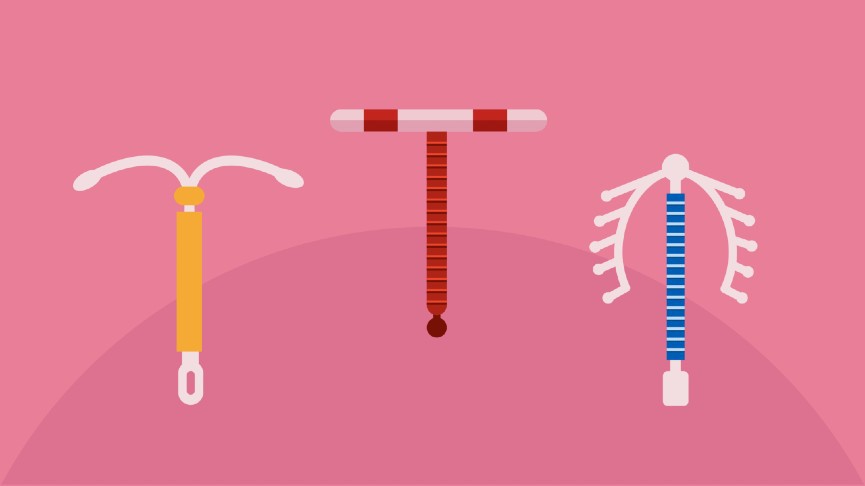Your IUD Questions Answered

Finding the right birth control option is an individual journey between you, your body, and possibly your partner. You also may find that your needs shift as you get older, and get to know your body better.
One birth control option that is slowly gaining popularity are IUDs. These seemingly mystical devices may bring up a whole string of questions. Intimina is here to answer them for you.
What is an IUD?
First things first, what on Earth is an IUD?
An IUD, short for intrauterine device, is a tiny T-shaped contraceptive device that lives inside your uterus. It’s also sometimes called a coil.
This tiny object has the power to keep you from getting pregnant using either copper or hormones.
What Kind of IUDs Are There?
Like we mentioned, there are two kinds of IUDs, hormonal and copper.
Currently, there are four different brands of hormonal IUDs available that release the hormone progestin levonorgestrel. This hormone makes the uterus a hostile environment for sperm and eggs, preventing sperm from making it to the egg in the first place. They do this by thickening the cervical mucus, and thinning out the lining of the uterus.
The hormonal IUD can also be used to treat heavy periods and endometriosis in addition to its contraceptive perks.
Copper IUDs are non-hormonal, and work by releasing copper ions (molecules) into the cervix, making it a no man’s land for sperm.
Copper is so toxic to sperm that they are killed, then essentially eaten by other cells, while also being decapitated, or detached from its tail.
Bad for the sperm involved, great for your contraceptive purposes.
How Long Does an IUD Last?
It depends on what kind of IUD you have.
Depending on the brand, hormonal IUDs can last anywhere from three to seven years, while the copper IUD is approved for up to ten years.
Ask your provider how long yours is good for, and be sure to write down somewhere when you got it, so that you know when you’ll need to replace it.
How Effective are IUDs?
IUDs are more than 99% effective, making them a fan favorite amongst reproductive healthcare providers.
Why are they so effective?
Unlike the pill or condoms, you don’t have to think about it, which leaves very little room for error.
Like any non-permanent form of birth control, IUDs are not 100% effective. The failure rate is very slim though, at less than one percent. If pregnancy does occur however, there is a higher risk of an ectopic pregnancy if this does happen.
What is The Insertion Process Like?
After discussing your medical history, and giving a gynecological exam, your provider will insert a speculum into your vagina, and then a special insertion device will place the IUD into your uterus, via your cervix. This process usually takes fives minutes or less.
It may be helpful to take an OTC ibuprofen an hour before your appointment to help with any cramping or discomfort.
You can have an IUD placed at any point in your menstrual cycle, as long as there is no chance that you are pregnant.
You may experience light spotting after insertion, no worries. Just pop on a pad or panty liner.
Do IUDs protect against STIs?
No, they do not. Which is why it’s important to still discuss your STD status, get tested regularly, and use condoms if you are with a new partner, or have multiple sexual partners.
Can You Feel it During Sex?
Probably not. There are strings that hang down from your IUD that will allow you and your provider to check its placement, and remove it when the time comes.
Usually, these strings are trimmed to just a few centimetres and will typically curl and soften against the cervix. While there’s a small chance your partner will feel the strings with a penis or fingers, it’s not likely.
If your partner does feel it during sex, there’s a chance that it’s not inserted properly. In this case, you can check with your provider to have it repositioned if needed.
Will I still Get My Period?
It depends on what kind of IUD you have.
For those with a hormonal IUD, your periods may be shorter, lighter, or gradually fade the longer your IUD is in place.
People who choose the copper IUD may experience heavier or longer periods. You also may have more spotting, especially during the first three months after insertion.
Can I still use a Menstrual Cup?
Yes!
Both people with the hormonal and copper IUD can use a menstrual cup during their period.
Period cups sit lower in the reproductive tract than IUDs, meaning there shouldn’t be any issues. Although you should wait two menstrual cycles after IUD insertion before turning to your trusty old cup again.
Can I Use an IUD After Giving Birth?
Yes, you can.
If you give birth at a hospital, you may be able to opt to have one inserted before you check out after birth. Although that may feel too soon for you after all that hard work you’ve done.
You can also ask your provider to insert one at your postpartum visit (typically six weeks), or whenever feels like the right time for you.
Can My IUD Fall Out?
It’s not likely, but it is possible. This happens most commonly in the first three months of after insertion, and during your period.
You can check for your strings to make sure it’s still there. If you think it may have fallen out (or you see it on your pad, tampon, menstrual cup), be sure to use condoms or another form of birth control until you’re able to get a new one inserted.
Are There Any Possible Side Effects or Complications?
Any side effects you experience from your IUD will most likely subside after three to six months. If your side effects are significantly affecting you, there’s no need to stick it out – talk to your doctor.
Side effects from the hormonal IUD are less likely than with say the pill, because the hormones are localized, but it is possible to experience weight gain, headaches, breast tenderness, mood fluctuations, acne, or change in libido.
The copper IUD may increase period cramps and menstrual pain, and in rare cases, it may embed and tear the uterine lining.
Although there is no clear data to back this up, there have been some reports of copper toxicity in the blood from the copper IUD.
There is also a slight risk of infection, usually at or around the time of insertion. This risk is slightly higher for the copper coil.
What if I Need to Get it Taken Out?
People choose to have their IUDs taken out all the time. Whether it’s because they want to try to conceive, or it’s just not right for them, you can always change your mind.
Just tell your provider it’s time, schedule an appointment, and voila! You’re IUD free.
Facts Checked By:

Dr. Shree Datta is a Consultant Obstetrician and Gynaecologist in London, specialising in women’s health including all menstrual problems such as fibroids and endometriosis. Dr. Shree is a keen advocate for patient choice, having written numerous articles and books to promote patient and clinician information. Her vision resonates with INTIMINA, with the common goals of demystifying periods and delivering the best possible care to her patients.
Article written by:

Natasha (she/her) is a full-spectrum doula and health+wellness copywriter. Her work focuses on deconstructing the shame, stigma, and barriers people carry around birth, sex, health, and beyond, to help people navigate through their lives with more education and empowerment. You can connect with Natasha on IG @natasha.s.weiss.


